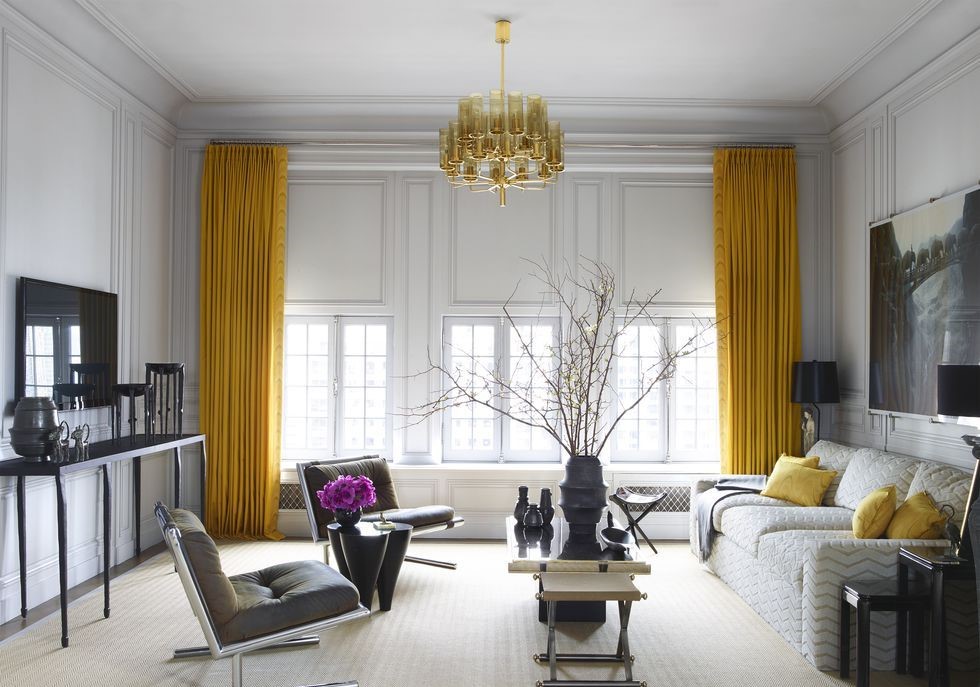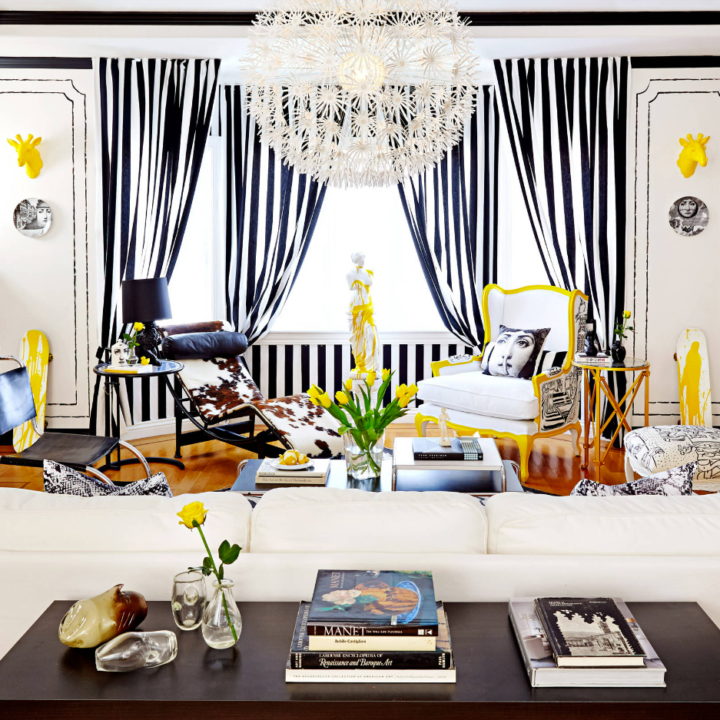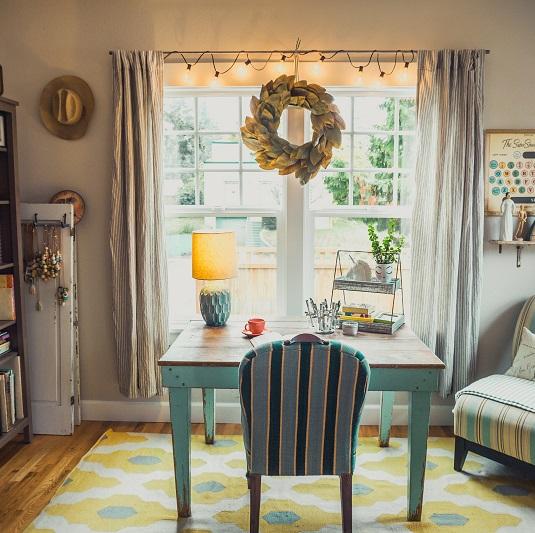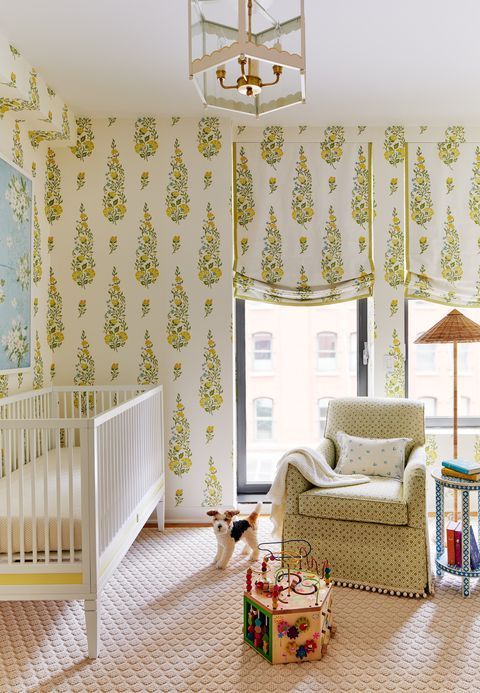Spiffy Speak
Living Room Window Treatments: Top Ideas & Tips

Homemakers and designers reserve special love and care when decorating living rooms because we make the most memorable moments with our family here. Get-togethers on special occasions and end-of-day catch-ups – all happen here with love, excitement, and preparation. Therefore, living room decor is perhaps one of the most important – and difficult – projects to get right at the first stroke. If living room window treatments are on your mind right now, this blog can be your one-stop reference on the type of treatments best suited to such a space.
Order custom window treatments for your living room from Spiffy Spools online in any size. Pick from over 3,000 fabrics and patterns!
Top Factors to Consider for Living Room Window Treatments
Unlike other rooms of the house, living room windows have unique requirements. Here, privacy is not quite the top priority but the option to provide it when needed should not be overlooked. Natural light must be welcomed but excess can be a problem as well. And while nailing these two factors, you must not lose sight of the aesthetic vision of the home.
It’s tricky but manageable if you clearly know what your priorities and preferences for living room window treatments are. Hence, we have this five-factor checklist for you to tackle this step of decision-making easily:
- PRIVACY VS. LIGHT: While living rooms are best when open and airy, if yours is exposed to busy neighborhoods, you might want a moderate level of privacy. Especially if your home has an open plan, you may do better by using fully functional window treatments for the living room. Also, a sun-kissed living room is the biggest asset of a well-designed home. So make sure to go for window treatments that do not block that beautiful energy from flooding your home. Though if you have sizzling summers or freezing winters, keep the option of a more insulative treatment alive as well.
- DECOR STYLE: Window treatments can be as maximalist or minimalist as one may want them to be. Some look industrial, others look natural, some are ornate, while others are simple. You need to identify your taste and your personal decor style to find the window treatment that best rhymes with it.
- EASE OF OPERATION: If the window treatments or windows may be operated often during the day, opt for treatments with easy accessibility and functional efficiency. Opening and closing the windows or the treatments must not take a whole lot of time and effort. Whereas, if the window treatments are mere decor accessories, opt for style over function. This factor should also play a role when picking double-layered treatments where one or both layers may be designed to remain static. For example, when you pair curtains and roman shades, curtains may be operated for light control and privacy while roman shades may be fixed at half-length of the window permanently. Here, curtains should be able to glide easily on the pole/track, while roman shades can be designed in decorative styles.
- AVAILABILITY OF SPACE: Sill-length treatments – like shades and blinds – often prove more suitable for small living rooms. Whereas, if you have the luxury of space, go for more elaborate treatments that match the proportion and grandeur of the space.
- SIZE OF WINDOW: If the windows are small, covering them with bulky treatments will look awkward. And if they are oversized, sill-length treatments will come over as a design mistake. So choose the window treatment in relation to the window’s scale and you’ll not go wrong with it.
Top Recommendations for Living Room Window Treatments
Living rooms need a good inflow of light and aesthetic excellence. None of these can be compromised to get the best out of your living room window dressing. While there are several options for window treatments available, not all are suitable for living rooms. Some are too invasive, while others are too austere for a space that’s meant to be dynamic and elegant. Hence, we save you some time by giving below our top five recommendations for living room window treatments.
Curtains & Drapes
Living rooms that aspire to be warm, inviting, and comfortable must look forward to window decor that anchors the space in coziness and homeliness. Therefore, curtains and drapes top our list as they overlay the ambiance with sumptuousness, softness, and superb style.
Drapes come with a choice overload of fabric types, colors, textures, patterns, and numerous curtain styles, hardware, and accessories, blowing up the design potential to an endless horizon. So, if your heart is set on curtains and drapes as much as ours, here are the things to be kept in mind:
MATERIAL: Depending on whether you’re going for a luxe vibe or a casual, lived-in feel, opt between statement fabrics and homely ones. Resplendent velvets and silks speak to the grandeur of a high-end living room with their stylish folds. On the other hand, cottons and linens define a semi-formal or completely laid-back approach.
Besides the palettes and patterns featured on fabrics, also consider the level of opacity you want for privacy, in conjunction with the position and size of your windows.
A large-sized living room with picture windows can accommodate the volume of densely pleated drapery constructed from heavyweight fabrics. In a small room, however, you may find a better friend in sheer linen curtains that filter light softly, keeping the living room bright and airy.
With the obvious exception of sheers, we highly recommend lining the drapes to protect the expensive furniture and delicate fabrics of your living room from premature weathering. Based on the level of light control your living area needs, choose between privacy lining and blackout lining.
STYLES: Available in numerous styles, curtains can manifest your aesthetic preferences – extreme maximalism or stark minimalism, or a balance of both. No matter what decor style you follow, you will find a curtain style that echoes it.
There are curtain heading styles with fixed pleats such as the various types of pinch pleat drapes, while other styles – such as back tabs, grommet tops, etc – make a rippled contour by being gathered on the pole or track.
Some styles are highly architectural such as ripplefolds, while some are relaxed such as tab tops. Good old rod pockets and tie tops please rustic homes while simplistic flat panel tops complete contemporary living rooms.
So look out for curtain styles that best match your personal preferences and overall decor style. And, if you aim to operate your curtains often, prefer styles that employ rings, clips, or grommets as these allow for easy gliding.
For further tips on various heading styles, do read our Drapery Headings Style Guide.
LENGTH: The beauty of curtains largely depends on the way they fall and drape, which in turn is often determined by their length and weight. The longer and heavier, the better. Hence, floor-to-ceiling drapes are best suited to the living room, especially if it is arranged formally. The drapes must ideally graze the floor for non-fussy performance. That said, if you’re choosing decorative, dramatic drapes, they’ll look most opulent when the curtains are puddled on the floor.
If you can’t have full-scaled drapes for any reason – perhaps due to furniture or radiators underneath – consider other options. You may go for decorative curtain panels that frame the window and take up no functional role. Or, if you need functional window treatments, go for sill-length treatments such as shades or blinds. Or, combine shades/blinds with decorative curtains and get the best of both worlds.
WIDTH: The elegance of drapery lies not just in its drop, but also in its volume. The sumptuous use of fabric ensures well-rounded pleats, more insulation, and, in the case of sheers, more privacy. If you get the right material, palette, pattern, and length, but keep the pleats sparse, your lovingly-chosen drapes may end up looking cheap!
With a few exceptions, curtain styles in general look best when stitched in 2x to 3x fullness. That means if your window width is 100 inches, your curtains’ width should be 200-300 inches. For a deeper dig, check out our Drapery Measurement Guide.
HARDWARE: Whether you like to show or conceal the hardware, there are drapery heading styles that appease both tastes. If you do wish to expose your pole, consider show-worthy hardware that spells your decor style correctly.
If you like a seamless look instead, either choose to install traverse tracks or opt for curtain styles that completely cover the drapery pole/track such as rod pockets or back tabs.
Also, bear in mind that some curtain styles go only on drapery poles while others work on both poles and tracks. So, if you have pre-installed hardware in your home, do take account of it in the choice of the curtain style.
Bonus Tip: If space allows, mount the hardware with at least 6 inches of margin on top as well as sides of the window. This helps contain light leaks from the edges, provides stacking room so that the window gets cleared off, and makes the window look larger than it is.
READ MORE: LIVING ROOM CURTAIN IDEAS & TIPS: FROM MODERN TO TRADITIONAL
Roman Shades
Since drapes are first on our recommendation list, roman shades have to be the second, for though they function like blinds, they do it with the elegance of drapes. The most structured and least elaborate of all function-oriented fabric window treatments, roman shades fit the window in their exact dimensions, offering a custom-made appeal that is so precious for a well-styled living room.
With fabric choices ranging from posh velvets to sophisticated cottons, unlimited editions of colors and patterns, various fold styles, and gorgeous accessories, roman shades are a designer’s dream project.
If your living room windows happen to have a piece of furniture right below the sill, full-length drapes are not advised unless you can change the layout of your living room furniture. For most such settings, we highly recommend roman shades over drapes. Also, small living rooms with high traffic may profit from this sill-length treatment that demands no extra wall space or floor space.
If this sounds like your living room or if you’re piqued by the modern vibe of roman shades, follow further for the styling tips:
MATERIAL: As is the case with curtains, whether your living room is arranged formally or casually will influence the choice of fabric for the roman shades. So, while silk and velvet shades may go well with a formal setting, linen and cotton shades look slightly informal. Pick the fabric that best suits the level of formality of your living room. Also, consider the choice of sheerness or opacity levels in conjunction with the level of light inflow and privacy you desire.
MOUNT POSITION: You can either mount the roman shade within the window’s recess or outside on the wall above or the ceiling. Both positions are good, but either one may be more suitable for the particular settings of your living room. For example, if your window trim has ornate molding, inside mounting the shade helps to show them off. Whereas if your window is small, outside mounting the shade makes the entire opening available when it is drawn and also gives off the illusion of a larger window. For more insight on which position to choose, check our blog post on Outside vs Inside Mount Roman Shades.
STYLES: Roman shades come in various styles, each with a unique appeal and functional aspect. The flat fold roman shades, for example, are architectural in their appearance and most functional too. They are constructed with slats to support the formation of folds when they are operated.
The front-slatted shades show the silhouettes of these slats on the frontage. This style is ideal for solid-colored fabrics as the slats offer a pattern of horizontal stripes. Whereas, back-slatted shades have their slats inserted into the linings on the back. Hence, their frontage is clear and perfect for patterned fabrics to be presented without distortion. If you plan to operate the shades often, choose between two of these styles depending on whether the fabric is plain or patterned.
If you want more ornate roman shades that befit the opulence of your living room, we recommend relaxed roman shades. These are constructed without slats and have stylishly scalloped folds and bottoms. Since the folds in this style often need to be set manually, we recommend relaxed shades for windows where they can be left fixed at a semi-open level, save rare occasions that call for their operation.
READ MORE: LIVING ROOM ROMAN SHADES: TOP TIPS & TRICKS
Roller Blinds
If you are looking for sleek, function-oriented blinds for your living room, roller blinds are a worthy option.
Roller shades/blinds are one-piece window treatments attached to a sleek cassette at the top of the window from where they roll down and coil up as operated. They are almost always made of polyester, PVC or vinyl. Depending on the level of light control and privacy you desire in your living room, you can choose the degree of opacity from sheer, non-sheer and blackout.
Roller shades come in various colors and patterns, although the choice spectrum is not as wide as that of fabric treatments. They also come in various types to suit several different purposes.
For example, solar shades are made of a chemically treated fabric that keeps out UV rays and is recommended for extremely hot locales.
Zebra shades feature alternate bands of sheer and blackout material. The position of these bands can be adjusted to control the percentage of light that the shades block – from sheer to blackout – so you get the best of both in one go.
Hands down, the most significant advantage of roller blinds is not just their variety, but also their sleekness. When not in use, all you can see is the cassette, making the entire window available. But it may not be the most desirable quality for a window dressing if you are looking to add pizzazz beyond functionality.
Even when they are in functional mode, there is often very little they can offer for visual enhancement of the living room because of being extremely streamlined and texturally lacking. When used stand-alone, they are spot on for ultra-minimalist living rooms but will feel out of place in a living room designed on maximalist or warmer aesthetics. Hence, we highly recommend they be layered with drapes and not used as stand-alone treatments in living rooms.
Faux Shades & Valances
If your living room windows are looking for impeccable style elements but not for any light control or privacy, we recommend this fourth option. Faux roman shades and valances dress the top fourth of the window and provide a layer of texture, color, and pattern to enrich the beauty of the living room. They are stationary one-piece treatments that cannot be opened or closed but continue to dress the window trim even when the window is open.
Being made of fabric, valances are capable of bringing any color or pattern you can imagine to your living room. If you want to bring in a zesty color or a vibrant pattern, there’s no better excuse than a valance. Since it occupies very little optical space, you can be sure that it won’t go over the top.
If you like the idea of living room valances and yet don’t want them to seem as such, try our faux roman shade valances. These are pole-mounted, miniature decorative elements whose folds are secured by stitches. Hence, they easily pass for roman shades, given their external appearance, without being fully functional.
Our valances can be either board-mounted or pole-mounted. They come in various styles – some simple, some elaborate, some modern, and some classic. Depending on the decor style of your home, you can choose from over a dozen styles available with us.
If your living room has been designed formally, explore one of the board-mounted valances such as the board-mounted scalloped valance or board-mounted modern flat valance. They make their presence felt and are quite regal in their bearing.
Casual living rooms, on the other hand, may look aptly dressed in pole-mounted valances. Consider pole-mounted inverted box pleat valance or pole-mounted scalloped valance which have ornamental features but are not overdone.
If your living room has to fulfill both the casual and the formal roles, you might want a go-between. Consider a board-mounted box pleat valance or board-mounted sheffield valance as both of these are dressy, yet slightly casual.
READ MORE: LIVING ROOM VALANCE IDEAS TO ZHUZH UP YOUR WINDOWS
Plantation Shutters
If you’re looking to add window treatments that will also give a facelift to the facade, there’s no looking further than plantation shutters. These are permanent renovations with high returns that positively impact your home’s resale value while adding to the aesthetic appeal. They fall in the category of louvered treatments that come with their own set of benefits.
While providing privacy, they allow air circulation and light inflow unhindered. The slats can be swiveled as per privacy level preferences and according to the direction of the sunlight.
And when you want to take advantage of the views outside, the shutters can be opened like bifold doors, clearing the entire opening. In this process, they don’t need much stacking room but the area around it has to be free for the bi-folds to function freely.
Made of solid wood, shutters come in various colors and sizes, and can be customized to personal preferences. They are hardy, long-lasting, and stand up to the elements really well. They are, therefore, a timeless addition to the home. Since shutters are custom-made permanent additions – they can be expensive – but relay a high-end look to the home instantly.
The downside to this pricey window treatment is that it is not ideal for those who are not yet in their ‘forever homes’. Even if you do manage to undo them and take them to your next home, they may not fit the windows there.
Besides, shutters tend to make the room look darker with all the slats obstructing light inflow. If you want a light-bathed living room, you’ll have to let go of privacy altogether. Besides, the slatted frontage also does a disservice of letting out thermal energy through the gaps, making you spend more on heating up the room during winter.
Further, you cannot place any furniture near the windows since they can’t be operated otherwise. And, the solid wood structure fails to bring softness and homeliness inside the home even though it adds a very uniform and elevated feature on the facade.
Shutters recede into the background like a simple architectural addition to the home and fail to bring color vibrance, pattern play, or cozy textures into the space. In keeping with the age of this treatment, it is a great option for houses designed in the beach, farmhouse, or coastal style. Their limited palettes and aesthetic appeal, however, fall very much out of place with modern or industrial settings.
Double-Layered Treatments for the Living Room
Often home stylists recommend double-layered window treatments for a wholesome appeal for the living room. Layering helps to bring more visual depth, colors, and motifs to play. It gives you the opportunity to bring two different colors and materials to the decor. For example, you can design one layer in neutrals and the other in a color that best defines your living room palette. Another pretty technique is to design one layer in patterns and the second in solids that accent them.
The idea is not to overload the living room windows but to be able to marry the elements in an attractive way. Given below are some of our top favorite double-layered living room window treatments.
Sheer Curtains & Opaque Drapes
Sheer curtains framed by opaque curtains is a great way to juxtapose two weaves and textures. While sheers work as the main layer of filtering light and air into the living room, the opaque drapes can act as decorative elements only, if you don’t want them fully functional. You can design one in neutrals and the other in colors or keep both in complementary colors.
Another way to arrange them is to hang multiple sheer panels alternately interspersed with narrow opaque panels.
Yet another pretty-looking window decor solution is to hang sheer curtains over opaque drapes. Here, the color of the opaque layer is diffused gently by the transparent layer on the front. It looks whimsical and drop-dead gorgeous.
SHOP NOW: CUSTOM SHEER CURTAINS FROM SPIFFY SPOOLS
Sheer Shades/Blinds and Opaque Curtains
If you love a combination of window treatments that open vertically and horizontally, try this option. Here, shades (or blinds) are constructed from a sheer or semi-sheer material that filters in light and air. Then, frame the blinds with opaque curtains that can be stationary or fully functional for full coverage, depending on your light/privacy needs in your living room.
READ MORE: HOW TO LAYER ROMAN SHADES WITH CURTAINS
Roller Shades and Roman Shades
If your home is designed in a contemporary style, this sleek double-layered treatment is apt. Install roller shades within the recess of the window and if the window is deep enough, mount the roman shades in front and you’ll have the most minimalistic combination ever. If not, mount the roman shade outside on the wall above the window.
Since it is roman shades that can be designed with great creative leverage, let them show off that talent as best as you would want them to. And complement that vibrance with neutral-toned roller blinds, so they can both accentuate and counterbalance each other’s elegance.
Depending on your family’s requirements you can decide what function each layer has to fulfill. The roller blinds can take up the light-filtering task and the roman shades can offer privacy and insulation. Alternatively, you can also choose roman shades to fulfill a decorative function to keep up with the high aesthetic expectations and low functional demands of the living room. So, instead of fully functional roman shades, faux roman shades can offer a slimmer option.
Since both layers operate vertically and stop at sill length, this option is both kid-friendly and pet-friendly. Small living rooms that lack wall space and floor space for elaborate window treatments profit from this option.
In Closing
Living rooms pretty much act like a preview of what visitors can expect to see in the rest of the home. It’s your design statement as well as the first and best impression you give your guests about how far you can go to let them feel welcome and comfortable. Hence, getting the right window treatment for your living room is imperative, and now made easy with this blog. We hope that the tips and ideas described here will be helpful in your living room design project. And wish you good luck with it!
Let us in on your shopping spree and explore our vast collection of 3000+ fabric window treatments for living rooms. Spiffy Spools is sure to win your heart, hop into your shopping bag, and dress up your living room windows!
READ MORE: WHY YOU SHOULD EXPERIMENT WITH YOUR LIVING ROOM LAYOUT













